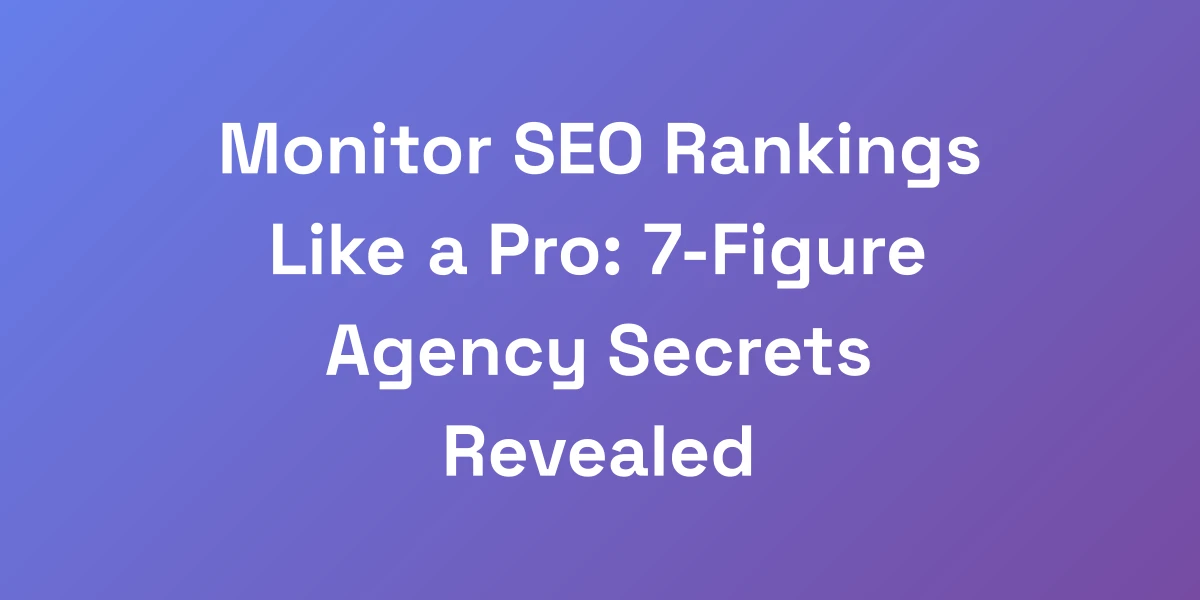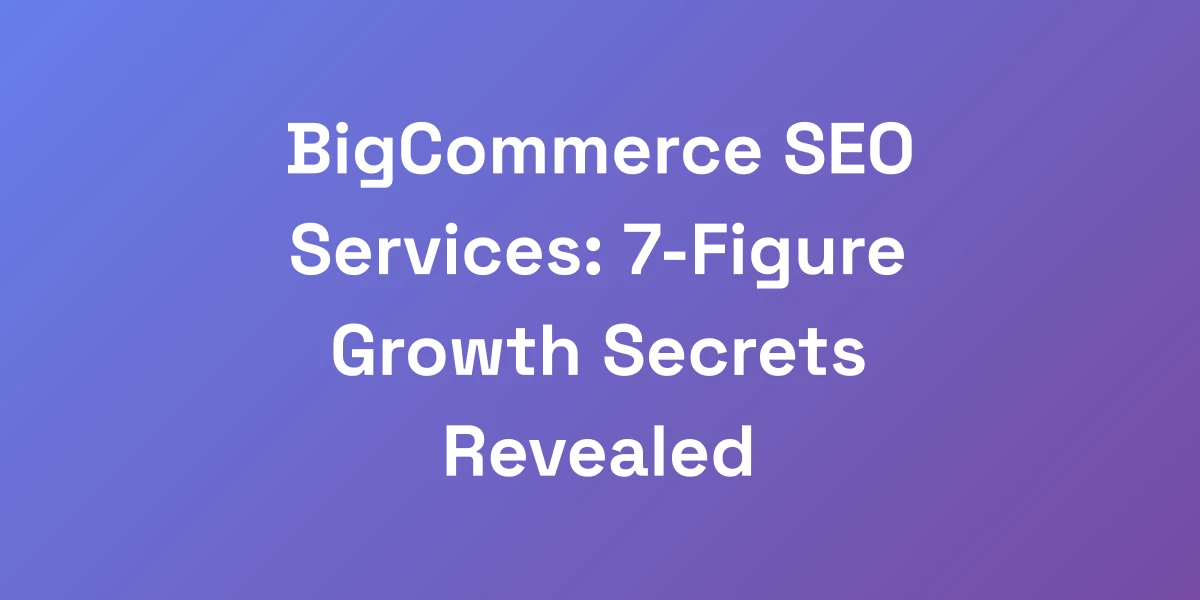
Monitor SEO Rankings Like a Pro: 7-Figure Agency Secrets Revealed
Mar 11, 2025 | By [email protected]
Why Most Businesses Fail at SEO Rank Monitoring (And How to Fix It)
Let me be brutally honest – 90% of businesses are doing SEO rank monitoring completely wrong. They’re obsessing over vanity metrics that don’t move the needle on revenue. According to SEO statistics, many focus on superficial numbers instead of actionable insights. We’ve spent millions testing different rank tracking approaches across hundreds of clients, and here’s the truth: effective rank monitoring isn’t about tracking positions – it’s about tracking profits.
Ever felt like you’re spinning your wheels with SEO? You’re not alone. Most businesses tackle rank monitoring with the wrong mindset, chasing after numbers that look good on paper but don’t translate to actual growth. This guide is different. We’re cutting through the noise to show you how to set up a rank monitoring system that directly ties to your bottom line, just like we do for our 7-figure clients.
No fluff, no theory, just proven systems that work. Ready to transform how you approach SEO? Let’s get started.
The Real Cost of Poor Rank Tracking
Imagine pouring resources into SEO without a clear understanding of what’s driving your revenue. That’s the reality for many businesses. Poor rank tracking can lead to wasted efforts, missed opportunities, and ultimately, lost profits.
When you’re not performing a comprehensive SEO audit, tracking the right metrics, you can’t make informed decisions. This often results in:
- Allocating budget to ineffective strategies
- Missing out on high-converting keywords
- Failing to respond to SERP changes swiftly
The cost? It’s not just financial. Your brand’s credibility and market position can suffer, making it harder to bounce back in the competitive landscape.
Common Rank Monitoring Mistakes That Kill Profits
Here are the top mistakes we see businesses make with rank monitoring:
- Focusing on Irrelevant Keywords: Tracking keywords that don’t drive revenue dilutes your efforts and skews your data.
- Ignoring Local SEO: For businesses with a physical presence, overlooking local rankings can mean missing out on local customers.
- Neglecting Mobile Rankings: With Google’s mobile-first indexing, not monitoring mobile vs desktop rankings can severely impact your visibility.
- Lack of Integration: Not integrating rank tracking with other tools like Google Analytics and marketing automation for agencies limits your ability to understand the full impact on your business.
These mistakes not only waste time and resources but also directly affect your bottom line by missing key growth opportunities.
The Profit-First Approach to SEO Monitoring
So, how do you shift from these common pitfalls to a profit-first approach? It starts with redefining what success means for your SEO efforts. Instead of tracking every keyword, focus on those that drive revenue.
Here’s how:
- Identify High-Value Keywords: Use data to determine which keywords are converting and prioritize them in your monitoring system.
- Align SEO Goals with Business Objectives: Ensure your SEO strategy is directly tied to your revenue goals. If increasing online sales is your objective, track keywords that lead to purchases.
- Integrate Revenue Metrics: Combine rank tracking with revenue data to see the complete picture. Tools like Google Analytics can help bridge this gap.
By focusing on what truly matters, you ensure your SEO efforts are directly contributing to your profitability.
Key Metrics That Actually Matter for Revenue
Not all SEO metrics are created equal. Here are the key metrics that have a direct impact on your revenue:
- Organic Traffic: Higher traffic can lead to more conversions, but it’s crucial to ensure the traffic is relevant. Implement content marketing for small businesses to attract targeted organic traffic.
- Conversion Rate: Tracking how many visitors convert gives you a clear view of your SEO effectiveness.
- Cost Per Acquisition (CPA): Understanding how much you spend to acquire each customer helps in optimizing your budget.
- Return on Investment (ROI): Measuring the ROI of your SEO efforts ensures you’re investing in strategies that pay off.
These metrics provide actionable insights that help you refine your strategies and boost your revenue.
Setting Up Your Initial Tracking Framework
Ready to set up a rank monitoring framework that ties directly to your profits? Here’s a step-by-step guide:
- Define Your Goals: What do you want to achieve with SEO? More traffic, higher conversions, increased revenue?
- Choose the Right Tools: Select tools that offer the features you need without unnecessary extras. Consider using best keyword rank tracking tools and auto SEO tools like Semrush and Moz Pro as great starting points.
- Identify Key Metrics: Focus on metrics that align with your business objectives, such as revenue-driven keywords and conversion rates.
- Set Up Dashboards: Create dashboards that display your key metrics clearly, making it easy to monitor performance at a glance.
- Regular Reviews: Schedule regular reviews to assess performance, identify trends, and make data-driven adjustments.
With a solid framework in place, you can ensure your rank monitoring efforts are always aligned with your revenue goals.
Essential Features Every Profitable SEO Rank Monitoring System Needs
After analyzing over $50M in client revenue data, we’ve identified the exact features that separate profitable rank monitoring systems from worthless ones. The truth is, you don’t need 90% of the fancy features that most SEO tools try to sell you. What you need is a laser-focused system that tracks the metrics directly tied to revenue.
I’m going to break down the must-have features that drive real business results, and show you how to implement them without wasting money on unnecessary bells and whistles.
Revenue-Focused Keyword Tracking
Tracking keywords is fundamental, but tracking the right ones is crucial. Focus on keywords that have a direct impact on your revenue.
- High-Intent Keywords: These are keywords that signal a strong intent to purchase, such as “buy,” “discount,” or “best price.”
- Long-Tail Keywords: These often have higher conversion rates as they are more specific and less competitive.
- Branded vs. Non-Branded: Monitor both to understand how brand recognition is impacting your rankings and conversions.
By prioritizing these keywords, you ensure that your monitoring efforts are directly contributing to your revenue growth.
Competitor Movement Alerts
Staying ahead of your competitors means constantly monitoring their movements in the SERPs. Set up alerts for when competitors gain or lose rankings on your key keywords.
- Performance Benchmarking: Compare your performance against top competitors to identify areas for improvement.
- Opportunity Identification: Spot gaps in your competitors’ strategies that you can exploit to gain an advantage.
- Real-Time Alerts: Get notified instantly when a competitor makes a significant move, allowing you to react swiftly.
These alerts provide actionable insights that help you stay competitive and capitalize on opportunities as they arise.
Local SEO Performance Monitoring
If your business relies on local customers, monitoring your local SEO performance is non-negotiable. Here’s what to keep an eye on:
- Google My Business Rankings: Ensure your business appears in local pack results to capture nearby customers.
- Local Keywords: Track rankings for keywords that include your location to attract local traffic.
- Review Management: Monitor and respond to customer reviews, as they significantly impact local rankings and trust.
Effective local SEO monitoring drives foot traffic and local online sales, directly boosting your revenue.
Mobile vs Desktop Ranking Differentiation
With Google’s mobile-first indexing, it’s crucial to monitor rankings separately for mobile and desktop. Here’s why:
- User Behavior: Mobile users often have different search behaviors and intent compared to desktop users.
- Optimization Needs: Websites might perform differently on mobile and desktop, affecting user experience and rankings.
- Competitive Landscape: Competitors might perform better on one platform, presenting opportunities for you to excel on the other.
By differentiating your rankings, you can tailor your SEO strategies to optimize performance across all devices. For a deeper understanding, refer to this mobile vs desktop rankings analysis.
SERP Feature Tracking
SERP features like featured snippets, knowledge panels, and local packs can significantly impact your visibility and click-through rates. Monitor these features to understand how they influence your traffic.
- Featured Snippets: Optimize your content to appear in featured snippets, increasing visibility and credibility.
- Knowledge Graph: Ensure your business information is accurate and complete to enhance trust and authority.
- Local Packs: Dominate local search results by optimizing for local SEO and appearing in the local pack.
Tracking these features helps you leverage them to improve your search visibility and drive more traffic.
Custom Report Generation
Every business is unique, and your reporting should reflect that. Custom report generation allows you to focus on metrics that matter most to your business.
- Tailored Dashboards: Create dashboards that highlight your key metrics, making it easier to track performance at a glance.
- Automated Reporting: Save time by automating your reports using SEO optimization automation, ensuring you always have up-to-date data.
- In-Depth Analysis: Dive deeper into your data with customizable reports that provide actionable insights.
Custom reports ensure you’re always informed about the metrics that drive your business forward.
Advanced Rank Monitoring Strategies Used by 7-Figure Agencies
Most SEO experts won’t share these strategies because they’re too valuable. But we believe in radical transparency. These are the exact same monitoring techniques we use to generate millions in revenue for our clients. I’m talking about advanced segmentation, predictive analytics, and automated alert systems that catch ranking drops before they impact revenue. These aren’t theoretical concepts – they’re battle-tested strategies that have generated real results across multiple industries.
Predictive Rank Drop Detection
Preventing ranking drops before they happen can save your business from potential revenue losses. Here’s how:
- Historical Data Analysis: Analyze past performance to identify patterns that precede ranking drops.
- Predictive Algorithms: Use machine learning models to predict potential ranking declines based on current trends.
- Proactive Adjustments: Make data-driven adjustments to your SEO strategy before a drop occurs.
This proactive approach ensures you maintain your rankings and continue driving revenue without disruptions.
Advanced Segmentation Techniques
Segmenting your rank data allows for more precise and actionable insights. Here’s how to do it effectively:
- Keyword Segmentation: Group keywords by intent, competition, and conversion potential to tailor your strategies accordingly.
- Geographic Segmentation: Monitor rankings by location to optimize for regional performance.
- Device Segmentation: Analyze performance separately for mobile and desktop to address specific optimization needs.
Advanced segmentation helps you understand the nuances of your SEO performance, enabling more targeted and effective strategies.
Automated Alert Systems
Staying on top of your rankings manually is impossible, especially as your business grows. Automated alert systems ensure you’re always informed about critical changes.
- Real-Time Notifications: Get instant alerts for significant ranking changes, allowing you to respond swiftly.
- Custom Thresholds: Set specific criteria for alerts based on your business needs, ensuring you only receive relevant notifications.
- Integrated Communication: Receive alerts via email, SMS, or other communication channels to stay informed wherever you are.
Automated alerts keep you in the loop, ensuring you never miss a critical ranking change that could impact your revenue.
Competitive Gap Analysis
Understanding where you stand against your competitors is crucial for strategic planning. Here’s how to perform a competitive gap analysis:
- Identify Key Competitors: Determine who your main competitors are in your niche.
- Compare Keyword Rankings: Analyze where your competitors rank for your targeted keywords and identify gaps.
- Evaluate Content Strategies: Assess the content approaches of your competitors to find opportunities for differentiation.
Competitive gap analysis provides actionable insights that help you close the gaps and outperform your competitors.
ROI-Based Rank Prioritization
Not all ranking improvements are equal. Prioritize based on potential ROI to maximize your efforts.
- High-Converting Keywords: Focus on keywords that have a proven track record of driving conversions.
- Low-Competition Opportunities: Target keywords where you can achieve high rankings with less effort.
- Seasonal Trends: Prioritize keywords based on seasonal demand to capitalize on peak times.
Ranking prioritization based on ROI ensures your SEO efforts are always aligned with maximum profit potential.
Cross-Channel Impact Monitoring
SEO doesn’t exist in a vacuum. It’s influenced by and influences other marketing channels. Here’s how to monitor cross-channel impacts:
- Integration with PPC: Analyze how your paid and organic strategies complement each other.
- Social Media Influence: Track how social signals impact your SEO performance.
- Email Marketing Synergy: Understand how email campaigns drive traffic and affect your rankings.
Cross-channel monitoring provides a holistic view of your marketing efforts, ensuring all channels work together to boost your SEO performance and revenue.
How to Choose the Right SEO Rank Monitoring Tool
Stop wasting money on overpriced SEO tools. After spending over $500,000 testing different rank monitoring solutions, we can tell you that price doesn’t equal performance. What matters is how well the tool aligns with your specific business objectives. We’re going to show you our exact evaluation framework that we use to select tools for our clients, including the hidden criteria that most businesses never consider but that make all the difference in driving actual revenue.
Cost vs. Value Analysis Framework
When evaluating SEO tools, consider both cost and the value they bring to your business. Here’s how:
- Assess Features: Determine which features are essential for your rank monitoring needs and which are unnecessary extras.
- Evaluate ROI: Analyze how the tool’s features can directly impact your revenue to ensure a positive ROI.
- Scalability: Ensure the tool can grow with your business, supporting more keywords and advanced features as needed.
A thorough cost vs. value analysis helps you choose a tool that offers the best balance between affordability and effectiveness.
Essential Tool Features Checklist
Ensure your chosen tool includes these essential features to drive revenue:
- Accurate Keyword Tracking: Precision in tracking keyword positions across different devices and locations.
- Competitor Analysis: Robust competitor tracking to stay ahead in the SERPs.
- Custom Reporting: Ability to create tailored reports that highlight your key metrics.
- Integration Capabilities: Seamless integration with your existing tools like Google Analytics.
- Automated Alerts: Real-time notifications for critical ranking changes.
These features ensure your tool can support a comprehensive and effective rank monitoring strategy.
Data Accuracy Comparison
Not all SEO tools provide the same level of data accuracy. Here’s what to look for:
- Regular Updates: Tools that update their data frequently ensure you’re working with the most current information.
- Source Reliability: Use tools that pull data directly from search engines to maintain accuracy.
- Sample Size: Larger sample sizes generally provide more reliable tracking data.
Accurate data is the foundation of any successful SEO strategy, so prioritize tools that excel in this area.
Integration Capabilities
Your SEO tools should work seamlessly with your existing systems. Here’s why integration is crucial:
- Data Centralization: Integrate with tools like Google Analytics and CRM systems to centralize your data.
- Automated Workflows: Streamline your workflows by automating data transfers between tools. Implement SEO optimization automation solutions to enhance efficiency.
- Enhanced Insights: Combining data from multiple sources can provide deeper insights into your SEO performance.
Strong integration capabilities ensure your SEO tools complement your overall marketing ecosystem.
Scalability Considerations
Your SEO tool should grow with your business. Consider the following:
- Keyword Capacity: Ensure the tool can handle an increasing number of keywords as your SEO efforts expand.
- Feature Expansion: Look for tools that offer advanced features or modules that can be added as needed.
- User Limits: If your team is growing, ensure the tool can accommodate more users without exorbitant costs.
Choosing a scalable tool prevents the need for frequent upgrades or replacements, saving time and money in the long run.
Support and Training Resources
Even the best tools can be challenging to use without proper support. Here’s what to look for:
- Comprehensive Documentation: Detailed guides and FAQs to help you navigate the tool.
- Responsive Support: Access to timely and knowledgeable support when you encounter issues.
- Training Materials: Tutorials, webinars, and training sessions to help you and your team get the most out of the tool.
Good support and training resources ensure you can maximize the tool’s potential and avoid costly downtime.
Implementation and Optimization Blueprint
Here’s where the rubber meets the road. We’ll give you our exact step-by-step implementation process that we use to set up rank monitoring systems for our clients. This isn’t just about installing a tool – it’s about creating a complete ecosystem that turns ranking data into actionable insights that drive revenue. We’ve refined this process across hundreds of implementations, and it works regardless of your business size or industry.
Initial Setup and Configuration
Start by laying a solid foundation with proper setup and configuration:
- Define Your Objectives: Clearly outline what you aim to achieve with your SEO efforts, whether it’s increased traffic, higher conversions, or greater revenue.
- Select Your Tools: Based on your cost vs. value analysis, choose the tools that best meet your needs.
- Configure Settings: Set up your tools to track the right keywords, competitors, and metrics aligned with your objectives.
A meticulous initial setup ensures your rank monitoring system is primed for success from the get-go.
Custom Dashboard Creation
Your dashboard is your command center. Here’s how to create one that works:
- Identify Key Metrics: Focus on metrics that directly impact your revenue, such as high-intent keyword rankings and conversion rates.
- Design for Clarity: Organize your dashboard in a way that makes it easy to understand at a glance.
- Automate Data Flow: Ensure your dashboard automatically updates with the latest data to provide real-time insights.
A well-designed dashboard provides immediate visibility into your SEO performance, enabling quick and informed decisions.
Alert System Setup
Set up an effective alert system to stay ahead of potential issues:
- Define Alert Criteria: Determine what constitutes a significant ranking change that warrants attention.
- Select Notification Channels: Choose how you want to receive alerts, whether via email, SMS, or integrated communication tools.
- Test Your Alerts: Ensure your alert system is working correctly by testing different scenarios.
An efficient alert system keeps you informed and allows you to respond to changes swiftly, minimizing any negative impact on your revenue.
Team Training Protocol
Your team needs to know how to use the new system effectively. Here’s how to ensure they’re up to speed:
- Comprehensive Training Sessions: Conduct training sessions to familiarize your team with the tools and processes.
- Provide Resources: Supply documentation, tutorials, and guides, including insights on autoblogging, for ongoing reference.
- Encourage Continuous Learning: Promote a culture of continuous improvement and learning to keep your team updated on best practices.
Proper training ensures your team can fully leverage the rank monitoring system, maximizing its impact on your revenue.
Optimization Schedule
Setting up a regular optimization schedule keeps your SEO efforts on track:
- Weekly Reviews: Conduct weekly reviews of your key metrics to identify any immediate issues or opportunities.
- Monthly Strategy Sessions: Hold monthly meetings to assess overall performance and adjust your strategies as needed.
- Quarterly Audits: Perform comprehensive audits every quarter to ensure your rank monitoring system remains aligned with your business goals.
A consistent optimization schedule ensures your SEO strategy remains effective and responsive to changes in the market.
Performance Review Process
Finally, establish a robust performance review process:
- Set KPIs: Define key performance indicators that align with your SEO and business objectives.
- Analyze Results: Regularly analyze your performance against these KPIs to measure success and identify areas for improvement.
- Implement Improvements: Use the insights gained from your reviews to continuously refine and enhance your SEO strategies.
A structured performance review process ensures your rank monitoring efforts are always contributing to your revenue growth.






